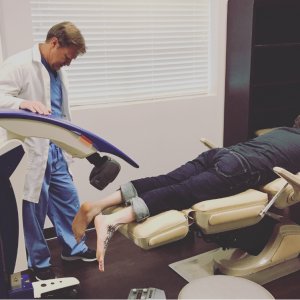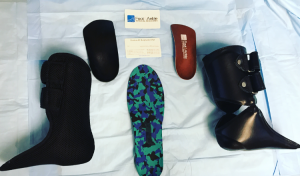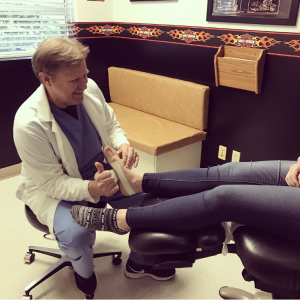As the weather warms up, we get more active. Some of us may be going out for sports, participating in marathons, planting a garden or going on hikes. If you’ve spent the winter off, all of these fun activities can result in an injury to an out-of-shape body. Dr. Thomas Burghardt a board-certified physician and surgeon at Foot & Ankle Surgical Associates says his office is full of new injuries in springtime. To help keep you out of the doctor’s office, he is sharing common risks and ways to avoid an injury as you start moving more.
“We see a lot of overuse injuries in the spring,” Dr. Burghardt says. “With the nicer weather, people want to go out and run a marathon. But the problem is they took the fall and winter off. These people are at a higher risk for injury because their bodies are not in shape.”

Dr. Burghardt sees a lot of sprains and strains in the spring. “We see ankle sprains from all the sports – basketball, baseball, soccer – you name it,” he adds. They also see fractures in the ankle, although they are not as common.
Other risks people may not think about are tendonitis and plantar fasciitis. Both of these conditions can be caused by overuse of your tendons and ligaments in your feet, especially when you are not in shape for the activity you are trying to do.
Non-strenuous activities can cause injuries just the same as if you were playing a sport or running a marathon. Even someone who had no desire to exercise, but is spending time mowing the lawn, gardening or taking the dog for longer walks, may find themselves with foot pain related to overuse. “Plantar fasciitis is one of the main things we see very frequently in the spring,” Dr. Burghardt says. “And it’s not just sports injuries, but people just getting busier in general. They go outside and walk. They are mowing their lawns and wearing bad equipment, bad shoes, with not enough support.”
Kids tend to get sprains and strains more than tendonitis or plantar fasciitis. Little kids can get growth plate injuries as well. For example, a lot of kid soccer players get apophysitis, inflammation of the growth plate in their heel, which causes heel pain.
How to Get in Shape without Injury

Follow Dr. Burghardt’s tips to get back in shape this spring without injury:
- Build Distance Slowly
It’s finally warm and you saw a flyer at your local coffee shop for a run. It’s a week away. You get all excited and enter – what’s a little 5k, after all? But doing this is a great way to cause an injury. “If you try to go from zero to sixty, like running a marathon just a few days after you started running again, you will end up with pain,” Dr. Burghardt cautions. Instead, start out slowly and for short periods of time, gradually building up your endurance as your body gets back in shape he says.
- Get New Shoes
One of the leading factors in injuries is improper foot wear Dr. Burghardt says. And warm-weather shoes tend to be the worst. If you are mowing your lawn in rubber boots, which have no support, or going for a walk in your flip flops or flats, you are increasing the chances of a foot injury. “Wear those athletic shoes on your trip to Disneyland,” he adds.
For athletes, it’s important they wear the proper type of shoe. Runners should wear shoes made for running. Tennis players should wear tennis shoes, etc. Be sure to inspect last year’s shoes and make sure they are still in good shape. Injuries happen when someone is wearing a worn-out shoe that no longer gives the support and protection it once did, Dr. Burghardt cautions. “A runner’s shoes should be replaced about every 500 miles,” he adds. Otherwise, you could end up with an overuse injury.
-

Foot & Ankle Surgical Associates has both over-the-counter and prescription braces and orthotics to provide stability and support for any activity. Photo credit: Foot & Ankle Surgical Associates Consider Orthotics
Over-the-counter orthotics can be helpful for preventing injuries, especially if you have a foot shape that is prone to them. Look for something sturdy, he says, the really soft inserts actually make your foot work harder. They are good for standing for long periods, but not moving around.
“It really is harder on your feet if the insert is too soft,” says Dr. Burghardt. “The analogy I like to give is if you go to the beach and you put your feet in the sand. It feels great, but if you try to walk, it’s twice as hard in that soft sand. Most of the time that soft insert will actually make pain you already have worse.”
If you need something that particular, Foot & Ankle Surgical Associates has prescription orthotics that are made to fit your foot.
- Add Stretching to Your Routine
Thorough stretching is extremely important to help avoid injuries. You need to stretch before and after you exercise, Dr. Burghardt says, and when it comes to your foot, the most important stretch is for your calf.
“Your calf really dictates everything that happens below it,” he says. “If your calves are tight, it can put pressure on your forefoot. It can also cause you to pronate more because your foot can’t go heel to toe, so instead it rolls to the side, which causes injury.”
- Ice Your Injury
If after you stretch you have some soreness, Dr. Burghardt recommends icing and then resting. This will help a lot, especially if you have a pre-existing injury or past injury. “RICE” is still a good standard for treating any pain related to these types of issues, he adds.
What to Do If An Injury Occurs

Even with all the prevention in the world, injuries still happen. So then what? Most important is rest, Dr. Burghardt says. Don’t keeping moving on that injured foot. It needs rest to heal, otherwise it may become a chronic issue. Then, it’s time to call a doctor. Foot & Ankle Surgical Associates wants to get you back up and running as soon as possible and have several treatments available to do just that, including new technology that can really speed recovery.
Aside from surgery, prescription orthotics, and physical and massage therapy, Foot & Ankle Surgical Associates has platelet rich plasma (PRP) injections. Their clinic has been using PRP to treat achilles tendonitis and plantar fasciitis, along with other injuries. A patient’s blood is used and spun to concentrate platelets that are then pulled off and injected back into the injured area. It stimulates the growth proteins, which speeds up healing. Unlike steroid injections, PRP has none of the side-effects and is legal for use in sports.
“It can be a really miraculous recovery. Not every time, but a lot of the time,” he says. “We’ve used PRP on patients who have been sore for years with achilles tears or partial tears, and with PRP they suddenly get better in just a few weeks.”
Foot & Ankle Surgical Associates also has MLS laser therapy that works well for chronic and acute injuries. “It’s a cold laser that penetrates deep below the skin and aids in anti-inflammation,” Dr. Burghardt explains. “It also promotes healing of the injured tendon or muscle.”
Remember to start slowly, wear proper shoes, and if you do feel pain, stop and get your foot checked out. Ignoring the injury will just prolong the recovery period. If you already have an injury, Foot & Ankle Surgical Associates has five locations to get you moving again. Visit their website for more information, including locations.
Sponsored











































